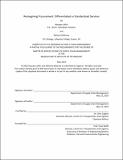| dc.description.abstract | Our sponsor company is a leading player in the healthcare market. Its procurement organization is split into three divisions: corporate, business unit, and global services. The procurement strategy is set by corporate procurement, and then business unit and global services perform the procurement execution, and measure their procurement through metrics in experience, efficiency, and effectiveness. Our main question was whether the policies set by corporate procurement, such as supplier segmentation, are beneficial to those metrics in procurement execution, and whether the procurement process could be re-engineered to improve those metrics. We conducted an analysis of transaction data, created a Value Stream Map, and utilized process mining technology to assess the current process. We then used the principles of process re-engineering to redesign the end-to-end process. We concluded that the policies set by corporate procurement were not beneficial to procurement execution metrics, as the most effort was being placed on the least important segment of suppliers. We created a re- engineered process, which promotes technology such as machine learning, which could lead to improved procurement process metrics. | en_US |
